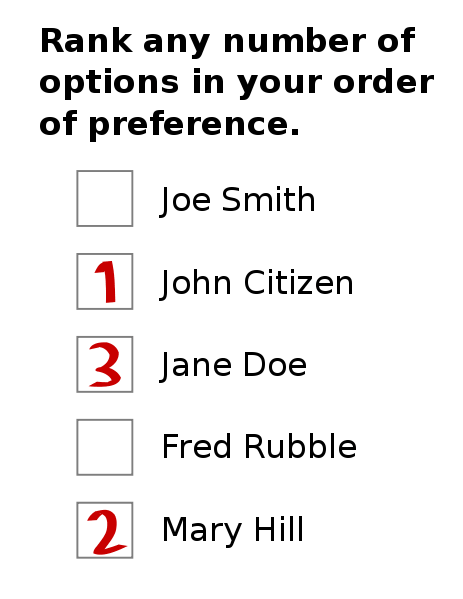
Michael Ossipoff’s Election Methods Properties Series
Main Categories of Properties and Criteria.
2. List of Pass/Fail Criteria That Will Be Used (Without Definitions)
3. Cast of Characters
List of the Methods Being Compared (Without Definitions).
The Section on Each Method Will Conclude With a Compact List of the Names of its Compliances and Desirable Properties.
In topic 4, properties, including criterion-compliances, will be discussed in order of importance starting with the criteria most relevant to strategy. Beginning with a general description of the method’s strategy, I will then discuss other important properties, such as count-fraud vulnerability and enactability, ending with some of the less important criteria.
5. (As Cross-Referencing) Properties and Criteria, With Complying and Failing Methods
Definitions of Any Discussed Properties Not Previously Defined.
6. Conclusions
Where We Are in Voting System Reform. The End of the Proposal-Selection Period is Overdue. Time for the Outreach and Enactment Period.
In my previous article, I listed some topics that would be covered in this series of Properties articles. This article continues where the previous one left off, in topic #4. That topic discusses, and, to some extent, compares, methods by a set of properties and criteria that I listed in my previous article.
4. Methods and Their Properties and Criterion-Compliances, Continued:
Condorcet Methods:
Condorcet methods meet the Condorcet Criterion. I’ll define it here:
A General Wording of the Unimproved Condorcet Criterion Definition
Requirements:
- The voting system must allow the voter to vote as many transitive pair wise preferences as desired. (Typically that’s in the form of an unlimited ranking)
- If there are one or more unbeaten candidates, then the winner should be an unbeaten candidate.
Traditional definition of beat:
(‘iff” means “if and only if”)
X beats Y iff more voters vote X over Y than vote Y over X.
Alternative definition of beat that is claimed to be more consistent with the preferences, intent, and wishes of equal-top-ranking voters:
(Argument supporting that claim can be found at the Symmetrical ICT article.)
(X>Y) means the number of ballots voting X over Y.
(Y>X) means the number of ballots voting Y over X.
(X=Y)T means the number of ballots voting X and Y at top
(A ballot votes a candidate at top if it doesn’t vote anyone over him/her)
“iff” means “if and only if”
X beats Y iff (X>Y) > (Y>X) + (X=Y)T
With this alternative definition of beat, FBC and the Condorcet Criterion are compatible.
Traditional Unimproved Condorcet (TUC):
TUC is a broad class of methods that uses the traditional definition of beat (stated above). That means that it meets the Condorcet Criterion (CC) when CC uses the traditional definition of beat. As before, in the previous article, with Approval and Score, the method will all be discussed and compared by the properties and criteria that I listed in my previous article.
TUC is popular because it’s been around for a long time. Sometimes, when something achieves that kind of traditional popularity, it becomes no longer subject to question. TUC is long overdue for questioning. Properties and Criterion Compliances of TUC:
a) Important Strategy Criteria:
a1) Favorite-Betrayal Criterion (FBC):
TUC fails FBC (defined in previous article). Briefly, a method that fails FBC can give incentive to bury one’s favorite—to vote other candidates over one’s favorite. Approval and Score don’t fail FBC. FBC is important because favorite-burial seriously distorts people’s preferences, and can make nonsense out of an election result, with obvious adverse societal results. Those adverse societal results are observable in our current electoral system that uses Plurality.
a2) Chicken Dilemma Criterion:
TUC, Approval, and Score all fail the Chicken Dilemma Criterion, defined below:
Chicken Dilemma Criterion Definition
Supporting definitions:
- The A voters are the voters who prefer candidate A to everyone else. The B voters are the voters who prefer candidate B to everyone else.
- The other candidates are the candidates other than A and B.
- A particular voter votes sincerely if s/he doesn’t falsify a preference, or fail to vote a felt preference that the balloting system in use would have allowed him/her to vote in addition to the preferences that s/he actually votes.
Premise:
- The A voters and the B voters, combined, add up to more than half of the voters in the election.
- The A voters and the B voters all prefer both A and B to the other candidates.
- The A voters are more numerous than are the B voters.
- Voting is sincere, except that the B voters refuse to vote A over anyone.
- Candidate A would be the unique winner under sincere voting (in other words, if the B voters voted sincerely, as do all the other voters).
Requirement: B doesn’t win.
In the chicken dilemma scenario described in the premise of the Chicken Dilemma Criterion (CD) defined above, if B won, then the B voters would have successfully taken advantage of the A voters’ cooperativeness. The A voters wanted to vote both A and B over the candidates disliked by both the A voters and B voters. Thereby they helped {A,B} against worse candidates. But they also helped the B voters to make B beat A. With methods that fail CD, the message is “You help, you lose.”
In previous articles, I discussed how Approval and Score can deal with the chicken dilemma, and additional reasons why it isn’t a problem with those methods. But, though it isn’t a problem, it can still be a nuisance.
I defined u/a elections in my previous article. U/a elections are important because they’re the kind of elections in which there is known strategy for more methods. Also, I claim that all of our official public elections are u/a elections. The best that the best rank methods can do, for u/a strategy, is to match Approval. The only exception to that statement is that some rank methods can automatically avoid the chicken dilemma—if they meet the Chicken Dilemma Criterion (CD) defined above. Therefore, it can accurately be said that a method doesn’t improve on Approval and Score unless it meets CD. There is no excuse for a rank method to fail CD. TUC fails CD.
a3) Condorcet Criterion (CC):
I defined CC above, in this article. CC can be regarded as a worthwhile strategy criterion. TUC is touted as meeting CC, in the form that uses the traditional definition of beat. But there’s a problem with that: Meeting CC only means something if there isn’t strong incentive or need for strategy that prevents the sincere voting that would make CC compliance meaningful and valuable. FBC failure and CD failure make meaningless TUC’s CC compliance.
In fairness, I should add that, when the chicken dilemma happens, it can give people reason to not approve an otherwise approvable second choice in Approval, and can thereby spoil Approval’s social optimizations that I described in the previous article.
But it should be noted that the chicken dilemma’s distortion of sincerity is temporary. The chicken dilemma is solvable and preventable, in the ways that I’ve described in previous articles. FBC failure, in contrast, doesn’t go away. Its favorite-burial need remains, as we all have noticed in our Plurality elections. So the attempt to cite CC compliance as an advantage of TUC over Approval and Score is problematic, questionable, and doubtful.
b) General Strategy Description of TUC:
U/a strategy is the kind of strategy that is most knowable. I claim that all of our official public elections are u/a. U/A Strategy of TUC: Unknown. With TUC, even in a u/a election, you won’t know what to do. There is a need to top-rank all of the acceptables. But the problem is that there is a cost and a risk in doing so: Top ranking a candidate can change the winner from another top-ranked candidate to your last choice. With TUC, you’d have to try to judge which acceptables are the ones really able and likely to win, and which are more likely to only have the role of a spoiler, if top-ranked. Guesswork. As I said, you won’t know what to do.
As I said above, the best that the best methods can do in a u/a election is to emulate Approval. TUC doesn’t even come close, with its unknown u/a strategy. And that’s just the top-end u/a strategy.
At bottom-end, even in a u/a election, optimal TUC strategy calls for ranking the unacceptables in some (guessed) reversed order of win-ability. This sort of thing is disliked by the people who discuss voting systems at the election-methods mailing list. But the TUC advocates there seem to conveniently forget about it.
c) Social Optimizations of TUC:
None. Someone could want to call CC compliance a social optimization, but it doesn’t qualify as one, in the sense that Approval’s social optimizations do. CC compliance is sometimes spoken of as a standard in and of itself but though such a standard needn’t be justified in terms of other standards, it should still be possible to tell us why we should regard it as a standard in its own right.
That hasn’t been done for CC compliance. CC is a valid strategy criterion, but not a social optimization.
It’s pointed out that a candidate who pairwise-beats each of the other candidates is more difficult to challenge and criticize after the election. His status as winner is easily defended. But other methods have equally good claims in that regard. The winner of an Approval election has convincing and un-challengeable status as winner, because more people have indicated that they approve of him/her, and consider him/her acceptable in comparison to the other candidates.
d) Ease of implementation and Count-Fraud Vulnerability of TUC:
In an election with N candidates, TUC (like any Condorcet method) requires about N times as much count labor as Approval or Score—N times as many tally marks to be made, in a headcount. For that reason, and because of the greater complexity of the count, most TUC advocates would count TUC by computer, using machine balloting. As you know, those things result in incomparably, qualitatively, greater count-fraud opportunity.
As regards count-fraud vulnerability, TUC, and any Condorcet method, is unacceptable. Conceivably, if the parties participating in a headcount could each muster N times as many members for the count-teams, then Condorcet methods could be do-able as headcount. But that headcount would still be enormously more complicated, and the greatly increased count-labor would still translate to greatly increased count-fraud opportunity.
e) Enact-ability of TUC:
There are infinitely many ways to count rank ballots. As I said before, someone could ask, “Why does your rank count instead of one of the many others?” Under the enact-ability heading, I told why Approval is uniquely enact-able.
f) Embarrassment Criteria and TUC:
f1) & f2) : Participation and Consistency:
In my previous article about the properties of Approval and Score, I stated that Approval meets all of the embarrassment criteria that I know of. In particular, Approval meets Participation and Consistency. TUC fails Participation and Consistency.
In other words, with TUC (or any Condorcet method), by showing up to vote, and voting your favorite over everyone else, you could cause your favorite to lose, where s/he would have won had you not shown up to vote; and a count of the ballots in an election could determine that the top half of town chose Smith, the bottom half of town chose Smith—but the town as a whole chose Jones. Those two ridiculous inconsistencies won’t happen with Approval or Score.
f3) Mono-Add-Top:
Another embarrassment criterion met by Approval and Score, but not TUC, is Mono-Add-Top. It’s a stronger version of Participation:
Mono-Add-Top:
If, without you voting, your favorite candidate would win, then the fact that you show up and vote your favorite at top shouldn’t cause your favorite to lose. To vote a candidate at top is to not vote anyone over him/her, but to vote him/her over one or more other candidates.
Mono-Add-Top differs from Participation in that its premise lets you vote other candidates at top with your favorite, whereas Participation’s premise stipulates that you vote your favorite over everyone else. That stipulation makes Participation easier to meet. But TUC fails it anyway.
f4) IIAC:
Another embarrassment criterion that Approval and Score pass, but TUC fails, is Independence from Irrelevant Alternatives (IIAC):
IIAC:
After the count has been conducted, and the winner determined, removing a non-winning candidate from the ballots and from the election, and then recounting the ballots, shouldn’t change the winner.
Are there any embarrassment criteria that TUC can meet? Sure. I don’t know of any that Approval and Score don’t meet too. Here are a few that TUC can meet:
f5) Mono-Add-Plump:
A significant weakening of Participation. If your favorite would win if you didn’t show up and vote, then showing up and voting your favorite over everyone else, and not voting anyone else over anyone, shouldn’t make your favorite lose.
To plump means to vote only for one candidate, and for no one else. Participation merely stipulates that you vote your favorite over everyone else. You could do that when ranking all of the candidates in order of preference. Mono-Add-Plump makes a more demanding premise stipulation, when it stipulates that you vote only for your favorite, and for no one else. Even in a rank method, you don’t rank anyone other than your favorite.
f6) Monotonicity:
Monotonicity:
If X wins, then modifying your ballot so as to vote X over someone you didn’t previously vote X over, and to not vote someone over X whom you previously voted over X (but not doing the reverse of either of those modifications) shouldn’t cause X to lose.
In other words, raising X on your ballot shouldn’t make X lose. Voting more favorably for X shouldn’t make X lose. Changing your ballot shouldn’t change the election result in a direction opposite to the direction in which you changed your ballot.
f7) Plurality Criterion:
Plurality Criterion
Never elect candidate X if, for some other candidate Y, the number of ballots voting Y at top is greater than the number of ballots voting X above bottom.
Approval and Score meet Mono-Add-Plump, Monotonicity, and the Plurality Criterion. So does TUC. TUC advocates are very forgiving of failure of Participation, Consistency and IIAC. Could that be because TUC fails those criteria?
TUC advocates draw the line at Mono-Add-Top failure, Monotonicity failure, and Plurality Criterion failure. Could that be because TUC passes those criteria? What a coincidence, that TUC advocates happen to forgive just those embarrassment criteria failures that their favorite methods are guilty of. Could it be that their standards are a bit self-servingly selective?
Clone Independence:
I’m not classifying Clone Independence among the strategy or embarrassment criteria, because it isn’t certain how its advocates classify it. I’m not posting a precise definition of it because, when at the election-methods mailing list, it was recently cited, for TUC, a precise definition wasn’t supplied when I requested one. But basically, Clone Independence says that adding a number candidates identical to X shouldn’t cause X or someone like him/her to win, or prevent X or someone like him/her to win.
I had asked, at the election-methods mailing list, what advantages TUC has, to mitigate its disadvantages with respect to Approval, Score, ICT, and Symmetrical ICT. The only answer posted was Clone Independence. But some say that Approval and Score meet Clone Independence. I asked that poster to describe a clone problem of Approval, Score, ICT, or Symmetrical ICT. He didn’t have an answer.
I mention these election-methods mailing list postings, because I felt that it was important, before submitting this article-series, that I give the TUC advocates at the election-methods mailing list a fair opportunity to tell what mitigating advantages they feel that TUC has. Clone Independence was the best that they could do, but no one could justify the claim or implication that Clone Independence favors TUC over Approval, Score, ICT, or Symmetrical ICT.
The next article in this series will continue topic #4, discussing the properties and criterion-compliances of ICT and Symmetrical ICT. That article will, of course, define those methods first.



Leave a Reply